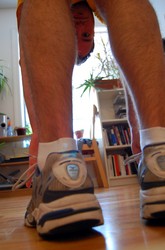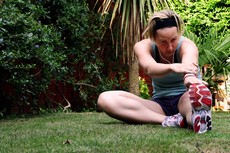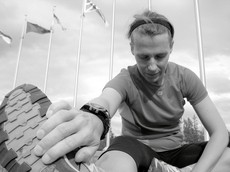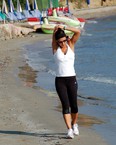 I am the first to admit that it took me a long while before being convinced of the benefits of stretching.
I am the first to admit that it took me a long while before being convinced of the benefits of stretching.
Many amateur athletes don’t place a lot of value on stretching. In some respects, it’s understandable. Time is a precious commodity, and stretching is often the first thing to go.
When you are doing speed drills in the pool, or cranking out mileage on your bike, or running hills, it feels like you are doing something worthwhile in your training. All that effort and sweat feels like work. Comparatively, stretching seems quite melodramatic. Heck, you hardly break a sweat, and it seems like you could be sipping your Caramel Macchiato while you do it! It doesn’t seem very Ironman-ish.
But stretching is not just for wimps!
Notice I said “amateur” athletes don’t value stretching.
Professional athletes know how critical stretching is, and they make it a vital part of their training regimen year round.
There is no sport where stretching is more important than the sport of triathlon.
Stretch Training
Endurance sports such as triathlon requires the athlete to repeat the same muscle movement repeatedly and excessively.
Whether it’s your swim stroke, cycling cadence, or running motion, as your muscles contract repeatedly, the connective tissue shortens and tightens.
 Arm and leg muscles lose elasticity through repetitive movements — because those movements seldom go through a full range of motion.
Arm and leg muscles lose elasticity through repetitive movements — because those movements seldom go through a full range of motion.
Each stroke and stride stops short of full extension and complete flexion.
What Effect Does This Have On Your Success As A Triathlete?
Triathletes with higher flexibility and elasticity in their muscles, perform more effectively and efficiently than athletes with low-elasticity muscles.
Take swimming, a flexible shoulder allows the hand to recover close to the body, thus permitting a full role and a long stroke. An ankle capable of completely flattening out reduces drag while swimming.
Many people ask if flexibility is an advantage for a runner. The answer is, yes. For example, flexible quadriceps and hip flexors aid running by allowing the recovery leg to swing through a wider arc. Tightness in these muscle groups reduces the range of motion in the hip, increasing the energy cost of running.
During cycling, tight hamstrings limit your performance by restraining the leg during the down stroke. By preventing your leg from straightening, it reduces the force produced in your hip and knee extension. Some triathletes compensate by lowering their saddle, which only serves to further reduce force generation.
Tight hamstrings are also the common cause of a tight lower back, which can be problematic in each aspect of triathlon – swimming, biking, and running.
Stretching To Improve Recovery
In addition to improving performance, stretching has also been shown to aid in the recovery process, and has long been considered the most significant injury-prevention measure a triathlete can employ.
Many triathletes incorporate Pilates or Yoga into their triathlon training for the purpose of increasing flexibility and elasticity. There are also DVD resources you can purchase to help establish and carry out a consistent stretching routine, and books that cover stretching quite comprehensively.
Some people utilize stretching bands and a stretching (“swiss”) ball as part of their routine.
Here’s an example of a triathlon-specific stretching routine utilizing such an apparatus:
How To Incorporate A Basic Stretching Plan Into Your Training Program
1. Do static stretching (not ballistic stretching, which is bouncing movements).
There was a time when athletes did “ballistic” stretching, which involves bouncing movements. Later research proved this method to be ineffective and at times prone to cause injury while stretching.
Static stretching involves stretching the muscle to a level of slight discomfort (not pain), and holding that position for 30-60 seconds. Repeat each of the stretching exercises 2-3 times in succession.
2. Stretch after each training session. 
Doing a warm-up and mild stretch routine before a training session or competition is common, but your most significant stretching should be done after a training session when your muscles are warm and supple.
3. Stretch all areas — your lower body, upper body, and core muscles.
A good basic plan would include:
You can do the above routine in 15 minutes, repeating each stretch 3 times. It typically takes between 4 to 6 weeks to see significant flexibility movement.






